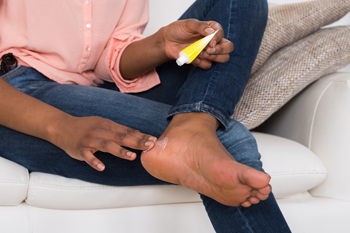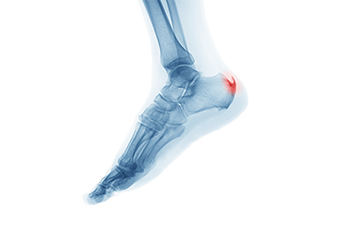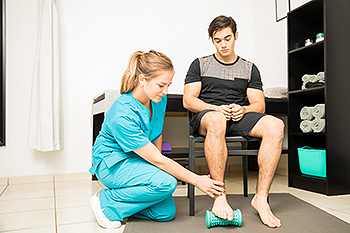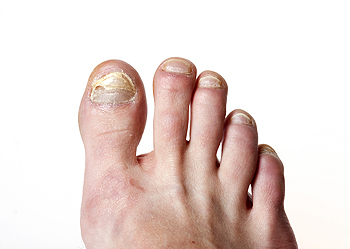Items filtered by date: July 2022
Reminder: When Was the Last Time...?
What Causes Cracked Heels

For any person who cares about the health and appearance of their feet, cracked heels can pose a unique problem. This unattractive and potentially uncomfortable condition occurs when the skin surrounding the heels becomes thick and dry, producing a cracked texture. It is very important to familiarize yourself with the causes of cracked heels as this can reduce your chance of developing the condition. The principal cause of this ailment is lacking sufficient moisture in the skin of the heels. For example, if someone fails to properly moisturize and protect the elasticity of the skin in their heels, they are increasing their chances of developing cracked heels. Additionally, prolonged exposure to water can also cause cracked heels in some cases. This is because water can diminish important oils in the heels that keep the skin elastic. Therefore, if you are someone who spends a significant amount of time in damp or moist environments, you may be putting yourself at a greater risk of developing cracked heels. These are just some of the many causes of cracked heels. To learn more, contact a podiatrist who can help with your cracked heels.
Cracked heels are unsightly and can cause further damage to your shoes and feet. If you have any concerns, contact one our our podiatrists from Newtown Comprehensive Foot Care. Our doctors can provide the care you need to keep you pain-free and on your feet.
Cracked Heels
Cracked heels appear unappealing and can make it harder for you walk around in sandals. Aside from looking unpleasant, cracked heels can also tear stockings, socks, and wear out your shoes. There are several methods to help restore a cracked heel and prevent further damage.
How Do You Get Them?
Dry skin is the number one culprit in creating cracked heels. Many athletes, walkers, joggers, and even swimmers suffer from cracked heels. Age and skin oil production play a role to getting cracked heels as well.
Promote Healing
Over the counter medicines can help, especially for those that need instant relief or who suffer from chronic dry feet.
Wear Socks – Wearing socks with medicated creams helps lock in moisture.
Moisturizers – Applying both day and night will help alleviate dryness which causes cracking.
Pumice Stones – These exfoliate and remove dead skin, which allows for smoother moisturizer application and better absorption into the skin.
Change in Diet
Eating healthy with a well-balanced diet will give the skin a fresh and radiant look. Your body responds to the kinds of food you ingest. Omega-3 fatty acids and zinc supplements can also revitalize skin tissue.
Most importantly, seek professional help if unsure how to proceed in treating cracked heels. A podiatrist will help you with any questions or information needed.
If you have any questions, please feel free to contact our office located in Newtown, CT . We offer the newest diagnostic and treatment technologies for all your foot care needs.
Do I Have a Heel Spur?

A common reason that people can have heel pain may be related to heel spurs. It is defined as a calcium deposit that develops on the bottom of the heel, and sometimes causes severe pain and discomfort. The band of tissue that runs along the sole of the foot is known as the plantar fascia. This helps the foot to withstand daily walking and standing, in addition to supporting the arch of the foot. If it is stretched beyond its limitations from overuse, the body may naturally respond by building extra bone, which is known as a heel spur. Contributing factors that may lead to this condition include wearing shoes that do not fit correctly, obesity, and advanced age. Common symptoms of a heel spur are pain in the bottom of the heel that can worsen while walking or running, and feeling a bump when the heel is touched. Mild relief may come from resting the affected foot as often as possible, and it can help to temporarily cut back on exercise as the foot heals. If you have heel pain, it is strongly suggested to consult with a podiatrist who can properly diagnose and treat heel spurs.
Heel spurs can be incredibly painful and sometimes may make you unable to participate in physical activities. To get medical care for your heel spurs, contact one our our podiatrists from Newtown Comprehensive Foot Care. Our doctors will do everything possible to treat your condition.
Heels Spurs
Heel spurs are formed by calcium deposits on the back of the foot where the heel is. This can also be caused by small fragments of bone breaking off one section of the foot, attaching onto the back of the foot. Heel spurs can also be bone growth on the back of the foot and may grow in the direction of the arch of the foot.
Older individuals usually suffer from heel spurs and pain sometimes intensifies with age. One of the main condition's spurs are related to is plantar fasciitis.
Pain
The pain associated with spurs is often because of weight placed on the feet. When someone is walking, their entire weight is concentrated on the feet. Bone spurs then have the tendency to affect other bones and tissues around the foot. As the pain continues, the feet will become tender and sensitive over time.
Treatments
There are many ways to treat heel spurs. If one is suffering from heel spurs in conjunction with pain, there are several methods for healing. Medication, surgery, and herbal care are some options.
If you have any questions feel free to contact our office located in Newtown, CT . We offer the latest in diagnostic and treatment technology to meet your needs.
What Is a Plantar Fibroma?

A plantar fibroma is a benign, noncancerous, growth that is less than one inch in size and develops in the arch of the foot. It grows in the plantar fascia, the thick, fibrous tissue that runs across the bottom of the foot and stabilizes the foot arch. A plantar fibroma can develop on one or both feet. Anyone can develop a plantar fibroma, but it is most apt to occur in young or middle-aged adults and males. This growth appears on the bottom of the foot in the middle of the arch. It is characterized by small bumps that can be painless at first but become painful as the nodules grow larger. Since there is no known cause of a plantar fibroma, there is no way to prevent it. If you suspect you have a plantar fibroma, consult with a podiatrist who can make a diagnosis and provide treatment for it, or any other foot or ankle condition found.
A plantar fibroma may disrupt your daily activities. If you have any concerns, contact one our our podiatrists of Newtown Comprehensive Foot Care. Our doctors can provide the care you need to keep you pain-free and on your feet.
Plantar Fibroma
A plantar fibroma is a fibrous knot in the arch of the foot. It is embedded in the plantar fascia which is a band of tissue that extends from the heel to the toes along the bottom of the foot. There can be multiple plantar fibromas in the feet at the same time. There are no known causes for this condition. If you have a plantar fibroma, there will be a bump in the arch of your foot that cannot be missed. Any associated pain is most often due to a shoe rubbing against the nodule. Non-surgical options, such as steroid injections, physical therapy, and orthotics should be tried first. Surgery is a last resort and is the only thing that will remove a plantar fibroma entirely. Consult with a podiatrist for a proper diagnosis and to determine the treatment regimen that is right for you.
What Causes a Plantar Fibroma?
While there are no specific causes identified, a plantar fibroma can possibly come from genetic predisposition or the formation of scar tissue that forms from healing the tears in the plantar fascia.
What Are the Symptoms of a Plantar Fibroma?
There will be a noticeable lump in the arch of the foot that may or may not cause pain. If pain is felt, it is typically because a shoe is rubbing up against the lump or when walking or standing barefoot.
Treatment and Prevention
A plantar fibroma will not disappear without treatment, but it can get smaller and be a non-issue. If pain persists, a podiatrist examines the foot and when the arch of the foot is pressed, pain can be felt down to the toes. An MRI or biopsy might be performed to help diagnose or evaluate the plantar fibroma. The following non-surgical options are generally enough to reduce the size and pain of these nodules:
- Steroid injections
- Orthotics
- Physical therapy to help apply anti-inflammatory creams on the bump
Surgery is considered if the mass increases in size and the patient continues to feel pain after non-surgical methods are tried.
If you have any questions please feel free to contact our office located in Newtown, CT . We offer the newest diagnostic tools and technology to treat your foot and ankle needs.
How Does Toenail Fungus Form and How Can You Address It?
 Toenail fungus can undoubtedly be an unpleasant and troublesome ailment of the foot. This condition often occurs when a case of athlete’s foot or another rash spreads to the toenail. Time is certainly of the essence when it comes to treating a toenail fungus. Since the fungus becomes more severe as time passes, an individual may be able to more effectively treat a toenail fungus if it is identified relatively early in its formation. To catch early forms of toenail fungus, you might be especially vigilant about identifying any yellow or white spots underneath the toenails. There are various types of treatment for toenail fungus that an individual has at their disposal. To treat the fungus, one might take an oral medication, especially when multiple toenails have been affected. Besides oral antifungals, other treatments include using topical medications for prolonged periods of time. The efficacy of these and other treatments often depend on how long the toenail fungus has been left untreated. It is suggested that you consult with a trusted podiatrist to address this ailment.
Toenail fungus can undoubtedly be an unpleasant and troublesome ailment of the foot. This condition often occurs when a case of athlete’s foot or another rash spreads to the toenail. Time is certainly of the essence when it comes to treating a toenail fungus. Since the fungus becomes more severe as time passes, an individual may be able to more effectively treat a toenail fungus if it is identified relatively early in its formation. To catch early forms of toenail fungus, you might be especially vigilant about identifying any yellow or white spots underneath the toenails. There are various types of treatment for toenail fungus that an individual has at their disposal. To treat the fungus, one might take an oral medication, especially when multiple toenails have been affected. Besides oral antifungals, other treatments include using topical medications for prolonged periods of time. The efficacy of these and other treatments often depend on how long the toenail fungus has been left untreated. It is suggested that you consult with a trusted podiatrist to address this ailment.
For more information about treatment, contact one our our podiatrists of Newtown Comprehensive Foot Care. Our doctors can provide the care you need to keep you pain-free and on your feet.
Toenail Fungus Treatment
Toenail fungus is a condition that affects many people and can be especially hard to get rid of. Fortunately, there are several methods to go about treating and avoiding it.
Antifungals & Deterrence
Oral antifungal medicine has been shown to be effective in many cases. It is important to consult with a podiatrist to determine the proper regiment for you, or potentially explore other options.
Applying foot powder on the feet and shoes helps keep the feet free of moisture and sweat.
Sandals or open toed shoes – Wearing these will allow air movement and help keep feet dry. They also expose your feet to light, which fungus cannot tolerate. Socks with moisture wicking material also help as well.
If you have any questions please feel free to contact our office located in Newtown, CT . We offer the newest diagnostic tools and technology to treat your foot and ankle needs.

